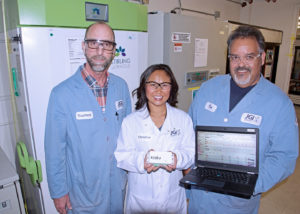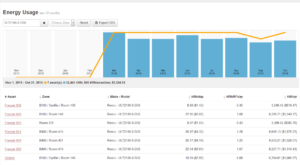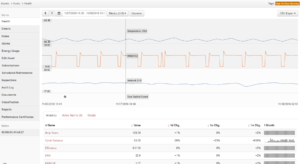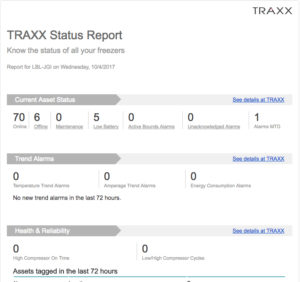Freezer Preventive Monitoring Program A Model of Berkeley Lab Energy Efficiency Efforts

The JGI Freezer Challenge Team (left to right): Tom Vess, Christine Naca and Don Miller in front of two freezers being monitored by the Klatu system. As part of JGI’s efforts to become more sustainable, Stirling freezers like the one on the left are being phased in because they use less than half of the energy consumed by the older freezer on the right.
It’s a common scene in popular culture, and it likely plays out in your own home: someone looking for a snack holds the refrigerator door open so long that eventually someone else complains that its cold enough for penguins to migrate from the South Pole. The energy spikes associated with keeping fridges at a constant, food-safe temperature can translate into significant financial costs and increased greenhouse gas emissions from power plants generating electricity to meet demand.
Laboratory freezers face similar energy demands, but unlike household fridges, they have to keep their contents frozen and not just cold. Additionally, they need to store those contents for months or years on end without thawing, and they’re not cleaned out as often, so if one breaks down, the results can be devastating for researchers. In an effort to raise awareness and optimize energy efficiency in freezer management, the International Institute for Sustainable Laboratories (I2SL) and My Green Lab organized the North American Freezer Challenge, a competition that tasked participants with demonstrating best practices for cold storage management.
The Challenge allowed labs to collect points for efforts such as cleaning out freezers, inventorying samples, and migrating samples from -80ºF to -70ºF freezers. Over 200 labs from 34 organizations entered the Freezer Challenge; JGI was one of five individual labs to receive Honorable Mention distinction. The Freezer Challenge winners were recognized in the October 5, 2017 issue of Nature, and were honored at the I2SL conference held in Boston on October 16, 2017.
Klatu for Monitoring Freezers
The JGI entry was led by Christine Naca, New Technology Implementation Program Manager, Don Miller and Tom Vess of the JGI Instrumentation team. Naca, who is also the head of the JGI’s Safety & Wellness (SWELL) Team and the 2017 Berkeley Lab Director’s Awardee for Exceptional Achievement in Safety, says the idea to participate was brought up by Sustainable Berkeley Lab’s Brie Fulton, and was motivated in large part by JGI’s sustainability initiatives. JGI’s freezer monitoring system (called “Klatu”) is a major investment in both time and money. It took six months to implement, another six months to set up at the JGI on all of the freezers, and requires onsite maintenance, but has demonstrated long-term benefits. The Klatu system was originally implemented at the JGI by a team led by Berkeley Lab Chief Sustainability Officer John Elliott, Erin Claybaugh – then Sustainability Program Manager for Sustainable Berkeley Lab, Don Miller, Tom Vess, Christine Naca, and JGI Operations Deputy Ray Turner.

Tracking a freezer’s energy consumption using the Klatu system
“As part of the JGI’s move to the IGB, we are taking a number of steps to reduce energy consumption which will get us closer to reaching LEED certification and cost-savings. One of the JGI’s contributions towards this goal involves phasing in Stirling freezers that cost more money but use less than half the energy of the freezers we have now,” Naca says. “Freezers are the most energy consuming piece of equipment and it’s been tough convincing researchers that a sample stored in a -80ºF will not degrade or suffer loss of quality if stored in a more energy-efficient -70ºF freezer. The Klatu system can help us demonstrate this.”
For the monitoring system to work, each unit of interest is wired with a mote (a small electronic box not much bigger than a smartphone) and data collecting sensors. The motes wirelessly transmit the collected data to the Klatu software stored in the cloud, and daily reports are emailed to the JGI staff overseeing all of the wired units. JGI Instrumentation Lab Manager Don Miller said there are 76 freezers and deli-style fridges with motes. Logging into the Klatu system, he shows the breadth of information available about each unit, from compressor cycle times, to how long a freezer door has been open, and even the ambient temperature outside of the unit.

Screenshot of the data the Klatu system collects
Every morning, he gets an emailed report summarizing the status of all the units; designated personnel in lab group who serve as first responders to freezer emergencies also receive daily emails about the specific units assigned to their areas.
“If any of the freezers alarm, they get emails and text messages, same as I do,” he says. “If a freezer fails, we have designated emergency backup freezers. But the Klatu system allows us to focus on preventing freezer failures rather than just responding after the freezer has failed.”
An Example of Lab Sustainability Efforts

Sample of a daily freezer status email
For the Freezer Challenge, points were awarded in categories such as the number of freezers on site, number of samples transitioned to a lower temperature freezer, and number of samples removed completely. As many of the data points could be tracked by Klatu, Sustainable Berkeley Lab reached out to see if JGI was interested in participating.
Along with the Klatu data collected by Miller and Vess, Naca says the JGI’s success in the Freezer Challenge highlights the efforts of dozens of JGI staff in multiple teams who worked on reducing the number of samples stored at various temperatures, discarding old or abandoned project samples and making more efficient use of existing freezer storage space. The group effort involved Sample Management led by Yuko Yoshinaga, Sequencing Technologies led by Chris Daum, and Supply Chain Manager Natasha Brown in the Project Management Office as part of the JGI’s Continuous Improvement Team (CIT). Samples stored by individual research labs at the JGI were not factored into the competition.
Naca says JGI’s participation in the competition was a good way to demonstrate the Lab’s efforts to find ways to become more sustainable, and Klatu has paid off in more ways than one. After seeing it in action, the company that responds to JGI’s service calls has also decided to implement the Klatu system. “They can see the value,” she said. By targeting maintenance efforts, JGI’s service vendor has been able to significantly reduce the number of freezers that are showing signs of failure, like having a compressor run too often. “Stressed out” freezers are more likely to fail and typically use more energy than a healthy freezer.
This award not only recognizes the achievements by the JGI team to efficiently manage their samples and energy, but also provides a model for the rest of the Lab, says Chief Sustainability Officer Elliott. “JGI is making all the right moves to strategically reduce their energy use while also lowering the chances that samples could be lost through freezer failure. Cold storage is the biggest equipment energy use at JGI. And plug-in equipment is expected to account for more than 60 percent of total energy use after JGI moves into its new, more energy efficient building on the main site. “JGI’s stewardship of its cold storage units using the Klatu system is inspiring and I think they have what it takes to win the Challenge next year.”